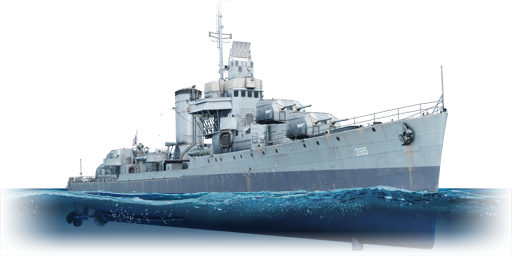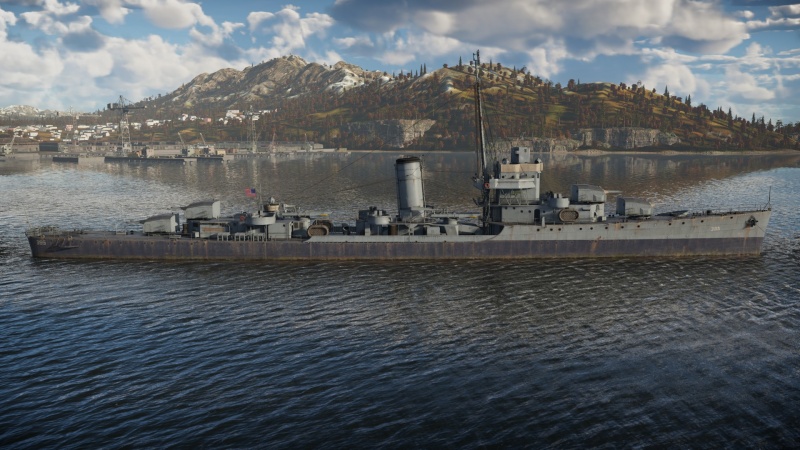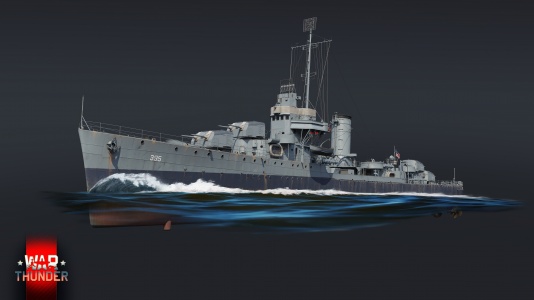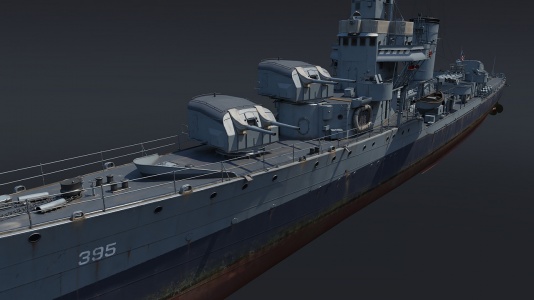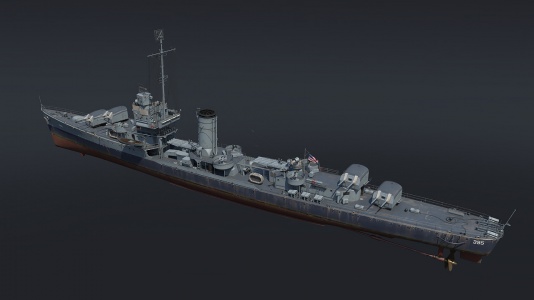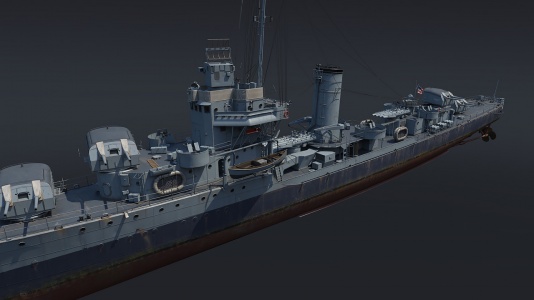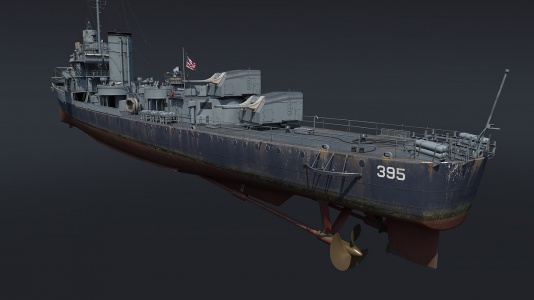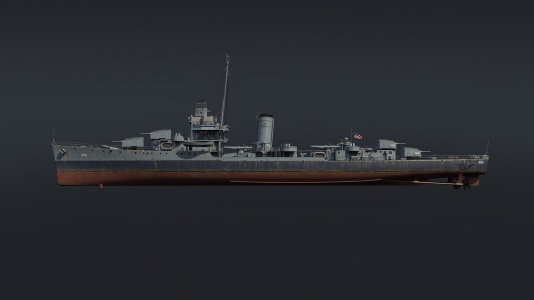Difference between revisions of "USS Davis"
Colok76286 (talk | contribs) (Edits) |
(→Description) |
||
| (7 intermediate revisions by 3 users not shown) | |||
| Line 7: | Line 7: | ||
== Description == | == Description == | ||
<!-- ''In the first part of the description, cover the history of the ship's creation and military application. In the second part, tell the reader about using this ship in the game. Add a screenshot: if a beginner player has a hard time remembering vehicles by name, a picture will help them identify the ship in question.'' --> | <!-- ''In the first part of the description, cover the history of the ship's creation and military application. In the second part, tell the reader about using this ship in the game. Add a screenshot: if a beginner player has a hard time remembering vehicles by name, a picture will help them identify the ship in question.'' --> | ||
| − | The '''{{Specs|name}}''' is a | + | The '''{{Specs|name}}''' was the fourth ship of the [[Somers (Family)|Somers-class]] destroyers. Laid down in July 1936, she wouldn't be commissioned until November 1938. Notably, DD-395 is the 3rd USN ship to be named after Rear Admiral Charles Henry Davis, and wasn't the last either. She would go on to serve in WW2, not seeing much action. Beginning the conflict in the Neutrality patrol, once the United States entered the war she would continue to serve in the Caribbean and Atlantic theaters of operation. While patrolling for the Normandy landings, she would repel a German E-boat attack, before suffering damage from a mine and having to be repaired. She would go back to convoy escort duties for the remainder of the war, before being decommissioned in 1945 after the close of the war. |
| + | |||
| + | Introduced as an event reward for [[wt:en/news/7640-event-the-battle-for-arachis-en|"Battle for Arachis"]] during [[Update "Wind of Change"]], USS Davis shares many similarities with other US destroyers of the rank. This includes the main armament of 8x {{Annotation|5-inch|127 mm}}/38, which is some of the strongest for destroyers, with good damage and excellent fire rate. It does have a smaller belt than the [[Porter (Family)|Porter class]], but in exchange it has much more crew, greatly increasing its survivability overall. This combination of firepower and survivability makes the Davis a menace when facing other destroyers and even many light cruisers. Additionally, the silver lion gain with the USS Davis is also extremely high; it has the highest modifier possible at 1,800%. | ||
== General info == | == General info == | ||
| Line 18: | Line 20: | ||
{{Specs-Fleet-Mobility}} | {{Specs-Fleet-Mobility}} | ||
<!-- ''Write about the ship's mobility. Evaluate its power and manoeuvrability, rudder rerouting speed, stopping speed at full tilt, with its maximum forward and reverse speed.'' --> | <!-- ''Write about the ship's mobility. Evaluate its power and manoeuvrability, rudder rerouting speed, stopping speed at full tilt, with its maximum forward and reverse speed.'' --> | ||
| − | + | With a flank speed of {{Annotation|37 kn|69 km/h;43 mph}}, USS Davis is a quick and nimble destroyer for USN captains. Responding to rudder commands within two seconds, captains should feel at ease manoeuvring near terrain, as in most cases rudder response will be quick enough to avoid grounding. Her speed falls to {{Annotation|26 kn|48 km/h;30 mph}} in a turn: captains should be prudent to avoid sustained turns, as Davis will be more liable to be hit and sustain damage at these lower speeds. USS Davis also responds well to engine room commands, taking 33 seconds to come to a halt and 29 seconds to accelerate to flank speed. | |
{{NavalMobility}} | {{NavalMobility}} | ||
| Line 33: | Line 35: | ||
''Provide information about the characteristics of the primary armament. Evaluate their efficacy in battle based on their reload speed, ballistics and the capacity of their shells. Add a link to the main article about the weapon: <code><nowiki>{{main|Weapon name (calibre)}}</nowiki></code>. Broadly describe the ammunition available for the primary armament, and provide recommendations on how to use it and which ammunition to choose.'' | ''Provide information about the characteristics of the primary armament. Evaluate their efficacy in battle based on their reload speed, ballistics and the capacity of their shells. Add a link to the main article about the weapon: <code><nowiki>{{main|Weapon name (calibre)}}</nowiki></code>. Broadly describe the ammunition available for the primary armament, and provide recommendations on how to use it and which ammunition to choose.'' | ||
| − | { | + | |
| − | + | {{:5 inch/38 Mk.12 (127 mm)/Ammunition|5 inch AAC Mk.34, 5 inch Common Mk.32, 5 inch SP Common Mk.46, 5 inch AAVT Mk.31}} | |
| − | |||
| − | |||
| − | |||
| − | |||
| − | |||
| − | |||
| − | |||
| − | |||
| − | |||
| − | |||
| − | |||
| − | |||
| − | |||
| − | |||
| − | |||
| − | |||
| − | |||
| − | |||
| − | |||
| − | |||
| − | |||
| − | |||
| − | |||
| − | |||
| − | |||
| − | |||
| − | |||
| − | |||
| − | |||
| − | |||
| − | | AAC Mk.34 | ||
| − | |||
| − | |||
| − | |||
| − | |||
| − | |||
| − | |||
| − | |||
| − | |||
| − | |||
| − | |||
| − | |||
| − | |||
| − | |||
| − | |||
| − | |||
| − | |||
| − | |||
| − | |||
| − | |||
| − | |||
| − | |||
| − | |||
| − | |||
| − | |||
| − | |||
=== Secondary armament === | === Secondary armament === | ||
| Line 98: | Line 44: | ||
''Some ships are fitted with weapons of various calibres. Secondary armaments are defined as weapons chosen with the control <code>Select secondary weapon</code>. Evaluate the secondary armaments and give advice on how to use them. Describe the ammunition available for the secondary armament. Provide recommendations on how to use them and which ammunition to choose. Remember that any anti-air armament, even heavy calibre weapons, belong in the next section. If there is no secondary armament, remove this section.'' | ''Some ships are fitted with weapons of various calibres. Secondary armaments are defined as weapons chosen with the control <code>Select secondary weapon</code>. Evaluate the secondary armaments and give advice on how to use them. Describe the ammunition available for the secondary armament. Provide recommendations on how to use them and which ammunition to choose. Remember that any anti-air armament, even heavy calibre weapons, belong in the next section. If there is no secondary armament, remove this section.'' | ||
| + | |||
| + | * '''Universal:''' {{Annotation|HEF-T|High-explosive fragmentation tracer}}{{-}}{{Annotation|HEF-I|High-explosive fragmentation incendiary}}{{-}}{{Annotation|AP-T|Armour-piercing tracer}} | ||
| + | * '''20 mm HE:''' {{Annotation|HEF-T|High-explosive fragmentation tracer}}{{-}}{{Annotation|HEF-I|High-explosive fragmentation incendiary}}{{-}}{{Annotation|AP-T|Armour-piercing tracer}}{{-}}{{Annotation|HEF-I|High-explosive fragmentation incendiary}} | ||
| + | * '''20 mm AP:''' {{Annotation|AP-T|Armour-piercing tracer}}{{-}}{{Annotation|AP-T|Armour-piercing tracer}}{{-}}{{Annotation|AP-T|Armour-piercing tracer}}{{-}}{{Annotation|HEF-I|High-explosive fragmentation incendiary}} | ||
| + | |||
| + | {{:20 mm/70 Oerlikon Mk.II (20 mm)/Ammunition|HEF-T, AP-T, HEF-I}} | ||
=== Additional armament === | === Additional armament === | ||
| Line 131: | Line 83: | ||
;Images | ;Images | ||
| − | <gallery mode="packed-hover" | + | <gallery mode="packed-hover" heights="200"> |
USS_Davis_WTWallpaper001.jpg | USS_Davis_WTWallpaper001.jpg | ||
USS_Davis_WTWallpaper002.jpg | USS_Davis_WTWallpaper002.jpg | ||
| Line 153: | Line 105: | ||
* ''other literature.'' --> | * ''other literature.'' --> | ||
| − | * [[wt:en/news/7631-development-battle-for-arachis-uss-davis-dd-395-destroyer-en|[Devblog] | + | * [[wt:en/news/7631-development-battle-for-arachis-uss-davis-dd-395-destroyer-en|[Devblog] "Battle for Arachis": USS Davis (DD-395) destroyer]] |
{{ShipManufacturer Bath Iron Works}} | {{ShipManufacturer Bath Iron Works}} | ||
{{USA destroyers}} | {{USA destroyers}} | ||
{{USA premium ships}} | {{USA premium ships}} | ||
Latest revision as of 09:12, 7 July 2024
Contents
Description
The Somers-class, USS Davis (DD-395), 1942 was the fourth ship of the Somers-class destroyers. Laid down in July 1936, she wouldn't be commissioned until November 1938. Notably, DD-395 is the 3rd USN ship to be named after Rear Admiral Charles Henry Davis, and wasn't the last either. She would go on to serve in WW2, not seeing much action. Beginning the conflict in the Neutrality patrol, once the United States entered the war she would continue to serve in the Caribbean and Atlantic theaters of operation. While patrolling for the Normandy landings, she would repel a German E-boat attack, before suffering damage from a mine and having to be repaired. She would go back to convoy escort duties for the remainder of the war, before being decommissioned in 1945 after the close of the war.
Introduced as an event reward for "Battle for Arachis" during Update "Wind of Change", USS Davis shares many similarities with other US destroyers of the rank. This includes the main armament of 8x 5-inch/38, which is some of the strongest for destroyers, with good damage and excellent fire rate. It does have a smaller belt than the Porter class, but in exchange it has much more crew, greatly increasing its survivability overall. This combination of firepower and survivability makes the Davis a menace when facing other destroyers and even many light cruisers. Additionally, the silver lion gain with the USS Davis is also extremely high; it has the highest modifier possible at 1,800%.
General info
Survivability and armour
Talk about the vehicle's armour. Note the most well-defended and most vulnerable zones, e.g. the ammo magazine. Evaluate the composition of components and assemblies responsible for movement and manoeuvrability. Evaluate the survivability of the primary and secondary armaments separately. Don't forget to mention the size of the crew, which plays an important role in fleet mechanics. Save tips on preserving survivability for the "Usage in battles" section. If necessary, use a graphical template to show the most well-protected or most vulnerable points in the armour.
Mobility
With a flank speed of 37 kn, USS Davis is a quick and nimble destroyer for USN captains. Responding to rudder commands within two seconds, captains should feel at ease manoeuvring near terrain, as in most cases rudder response will be quick enough to avoid grounding. Her speed falls to 26 kn in a turn: captains should be prudent to avoid sustained turns, as Davis will be more liable to be hit and sustain damage at these lower speeds. USS Davis also responds well to engine room commands, taking 33 seconds to come to a halt and 29 seconds to accelerate to flank speed.
| Mobility Characteristics | |||
|---|---|---|---|
| Game Mode | Upgrade Status | Maximum Speed (km/h) | |
| Forward | Reverse | ||
| AB | |||
| Upgraded | 85 | 31 | |
| RB/SB | |||
| Upgraded | 69 | 25 | |
Modifications and economy
Armament
Primary armament
Provide information about the characteristics of the primary armament. Evaluate their efficacy in battle based on their reload speed, ballistics and the capacity of their shells. Add a link to the main article about the weapon: {{main|Weapon name (calibre)}}. Broadly describe the ammunition available for the primary armament, and provide recommendations on how to use it and which ammunition to choose.
| Penetration statistics | |||||||
|---|---|---|---|---|---|---|---|
| Ammunition | Type of warhead |
Penetration @ 0° Angle of Attack (mm) | |||||
| 1,000 m | 2,500 m | 5,000 m | 7,500 m | 10,000 m | 15,000 m | ||
| AAC Mk.34 | HE | 36 | 36 | 36 | 36 | 36 | 36 |
| Common Mk.32 | Common | 124 | 103 | 77 | 58 | 46 | 37 |
| SP Common Mk.46 | SP Common | 150 | 125 | 93 | 71 | 56 | 45 |
| AAVT Mk.31 | HE-VT | 36 | 36 | 36 | 36 | 36 | 36 |
| Shell details | ||||||||||||
|---|---|---|---|---|---|---|---|---|---|---|---|---|
| Ammunition | Type of warhead |
Velocity (m/s) |
Projectile mass (kg) |
Fuse delay (s) |
Fuse sensitivity (mm) |
Explosive mass (TNT equivalent) (g) |
Ricochet | |||||
| 0% | 50% | 100% | ||||||||||
| AAC Mk.34 | HE | 792 | 25 | 0 | 0.1 | 3,220 | 79° | 80° | 81° | |||
| Common Mk.32 | Common | 792 | 24.49 | 0.01 | 6 | 1,150 | 47° | 60° | 65° | |||
| SP Common Mk.46 | SP Common | 792 | 25 | 0.01 | 6 | 906.5 | 48° | 63° | 71° | |||
| Proximity-fused shell details | ||||||||||||
|---|---|---|---|---|---|---|---|---|---|---|---|---|
| Ammunition | Type of warhead |
Velocity (m/s) |
Projectile mass (kg) |
Fuse delay (s) |
Fuse sensitivity (mm) |
Arming distance (m) |
Trigger radius (m) |
Explosive mass (TNT equivalent) (g) |
Ricochet | |||
| 0% | 50% | 100% | ||||||||||
| AAVT Mk.31 | HE-VT | 792 | 25 | 0 | 0.1 | 457 | 23 | 3,220 | 79° | 80° | 81° | |
Secondary armament
Some ships are fitted with weapons of various calibres. Secondary armaments are defined as weapons chosen with the control Select secondary weapon. Evaluate the secondary armaments and give advice on how to use them. Describe the ammunition available for the secondary armament. Provide recommendations on how to use them and which ammunition to choose. Remember that any anti-air armament, even heavy calibre weapons, belong in the next section. If there is no secondary armament, remove this section.
- Universal: HEF-T · HEF-I · AP-T
- 20 mm HE: HEF-T · HEF-I · AP-T · HEF-I
- 20 mm AP: AP-T · AP-T · AP-T · HEF-I
| Penetration statistics | |||||||
|---|---|---|---|---|---|---|---|
| Ammunition | Penetration @ 0° Angle of Attack (mm) | ||||||
| 10 m | 100 m | 500 m | 1,000 m | 1,500 m | 2,000 m | ||
| HEF-T | 2 | 2 | 2 | 2 | 2 | 2 | |
| AP-T | 34 | 32 | 24 | 17 | 12 | 8 | |
| HEF-I | 2 | 2 | 2 | 2 | 2 | 2 | |
| Shell details | ||||||||||||
|---|---|---|---|---|---|---|---|---|---|---|---|---|
| Ammunition | Velocity (m/s) |
Projectile mass (kg) |
Fuse delay (m) |
Fuse sensitivity (mm) |
Explosive mass (TNT equivalent) (g) |
Ricochet | ||||||
| 0% | 50% | 100% | ||||||||||
| HEF-T | 830 | 0.12 | 0 | 0.1 | 6.57 | 79° | 80° | 81° | ||||
| AP-T | 830 | 0.12 | - | - | - | 47° | 60° | 65° | ||||
| HEF-I | 830 | 0.12 | 0 | 0.1 | 11.17 | 79° | 80° | 81° | ||||
Additional armament
Describe the available additional armaments of the ship: depth charges, mines, torpedoes. Talk about their positions, available ammunition and launch features such as dead zones of torpedoes. If there is no additional armament, remove this section.
Usage in battles
Describe the technique of using this ship, the characteristics of her use in a team and tips on strategy. Abstain from writing an entire guide – don't try to provide a single point of view, but give the reader food for thought. Talk about the most dangerous opponents for this vehicle and provide recommendations on fighting them. If necessary, note the specifics of playing with this vehicle in various modes (AB, RB, SB).
Pros and cons
Summarise and briefly evaluate the vehicle in terms of its characteristics and combat effectiveness. Mark its pros and cons in the bulleted list. Try not to use more than 6 points for each of the characteristics. Avoid using categorical definitions such as "bad", "good" and the like - use substitutions with softer forms such as "inadequate" and "effective".
Pros:
Cons:
History
Describe the history of the creation and combat usage of the ship in more detail than in the introduction. If the historical reference turns out to be too long, take it to a separate article, taking a link to the article about the ship and adding a block "/History" (example: https://wiki.warthunder.com/(Ship-name)/History) and add a link to it here using the main template. Be sure to reference text and sources by using <ref></ref>, as well as adding them at the end of the article with <references />. This section may also include the ship's dev blog entry (if applicable) and the in-game encyclopedia description (under === In-game description ===, also if applicable).
Media
- Skins
- Images
See also
- Related development
External links
| Bath Iron Works | |
|---|---|
| Patrol Torpedo Boat (PT) | |
| 89’ Experimental PT | PT-810 |
| Destroyer Escorts (DE) | |
| Dealey-class | USS Dealey |
| Gun Destroyers (DD) | |
| Wickes-class | HMS Montgomery* |
| Somers-class | USS Davis |
| Gearing-class | USS Frank Knox |
| Destroyer Leaders (DL) | |
| Mitscher-class | USS Mitscher |
| *USS Wickes in UK service | |
| USA destroyers | |
|---|---|
| Clemson-class | USS Welborn C. Wood · USS Barker · USS Litchfield |
| Farragut-class | USS Aylwin |
| Bagley-class | USS Bagley |
| Porter-class | USS Porter · USS Phelps · USS Moffett |
| Somers-class | USS Somers · USS Davis |
| Fletcher-class | USS Fletcher · USS Bennion · USS Cowell |
| Allen M. Sumner-class | USS Sumner |
| Gearing-class | USS Gearing · USS Frank Knox |
| Mitscher-class | USS Mitscher · USS Wilkinson |
| USA premium ships | |
|---|---|
| Motor torpedo boats | PT-3 · PT-109 · PT-174 · Thunderbolt (PT-556) · PT-658 · PT-811 |
| Motor gun boats | LCM(6) Zippo · USS Douglas · USS Flagstaff |
| Sub-chasers | Carmi (PC-466) |
| Destroyers | USS Welborn C. Wood · USS Wilkinson · USS Bennion · USS Cowell · USS Davis · USS Moffett · USS Phelps · USS Frank Knox |
| Light cruisers | USS Detroit · USS Helena |
| Heavy cruisers | USS Des Moines |
| Battleships | USS Arkansas |


